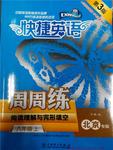题目内容
16.Characters in novels don't always do what the writer wants them to do.Sometimes they cause trouble,take on lives of their own,or even work against the writer.It's not just a problem for inexperienced authors:famed children's novelist Roald Dahl said he got the main character in his book Matilda so"wrong"that when he'd finished his first Version,he threw it away and started again.Of course it's not the characters'fault.The problem lies with the author.Take Stephen King,who admitted that writing working-class characters is more difficult nowadays because his own circumstances have changed."It is definitely harder,"King said."When I wrote Carrie many years ago,I was one step away from physical labour."
This is also true for characters'ages,added King."When you have small children,it is easy to write young characters because you observe them and you have them in your life all the time.But your kids grow up,it's been harder for me to write about this little 12-year-old girl in my new book because my roodels are gone."
For other authors,such as Karen Fowler,there's one quality that can stop a character in its tracks:boredom."I had particular problems with the main character in my historical novel Sister Noon,"she says."She had attitudes about race and religion that seemed appropriate to me for her time and class,but they were not attitudes I liked.Eventually I grew quite bored with her.You can write a book about a character you dislike or a character you disagree with,but I don't think you can write a book about a character who bores you."
According to Neel Mukherjee,it was Adinath,a character in The Lives of Others,who made him work the hardest."I think I struggled because it's difficult to write a character whose most prominent personal feature is weakness,as Adinath's is,without making that feature define him,"Mukherjee says.But a troublesome character is far from an unwelcome guest,he continues,arguing that"when characters work against the author they come alive and become unpredictable".
"That is a fantastic thing to happen,"Mukherjee says."I celebrate it.It is one of the great,lucky gifts given to a writer."
32.What can we infer about Stephen King's book Carrie?C
A.It was his most difficult book to write.
B.It was the first successful novel King wrote.
C.There were few children featured in the story.
D.Some of its main characters were working class.
33.Why did Karen Fowler have trouble writing the main character in her novel Sister Noon?D
A.She disagreed with the character's attitudes.
B.The age difference between the two was too large.
C.She found the character very uninteresting.
D.The historical setting made accuracy difficult.
34.What does Neel Mukherjee think of his difficult-to-write characters?B
A.They are a sign that the story is not realistic.
B.They are often the most interesting.
C.They should be praised by all authors.
D.They need to be researched more thoroughly.
35.In which part of the newspaper would you expect to find the passage?B
A.Careers.
B.Culture.
C.Entertainment.
D.Lifestyle.
分析 本文属于记叙文阅读,主要向我们讲述了一些作家笔下的小说人物是怎么写成的,并且向我们介绍了一些有名的作家所遇到的问题
解答 32.C 推理判断题.由第二段中的"Take Stephen King,who admitted that writing working-class characters is more difficult nowadays because his own circumstances have changed.It is definitely harder.When I wrote Carrie many years ago,I was one step away from physical labour"可知,多年前,他写作Carrie时,他所处的环境接近劳动阶层.而现在,他的生活环境发生变化了,所以对他来说现在描写劳动阶层更难了.由此可推知,Carrie这部小说中,主要人物应该有一些劳动阶层的人们.故选C
33.D 细节理解题.由第四段中的"You can write a book about a character you dislike or a character you disagree with,but I don't think you can write a book about a character who bores you"可知,Sister Noon这部小说中的主人公让作者感到很厌烦,故选D.
34.B 推理判断题.由倒数第二段中的"a troublesome character is far from an unwelcome guest …when characters work against the author they come alive and become unpredictable"可知,那些难写的人物在作家看来,往往是充满活力,令人不可预测的,故这样的人物是非常有趣的,很受作家的欢迎.故选B.
35.B 文章出处题.一些成名作家在写作时,描写的人物行为往往并不是按照作家的意愿进行的,有的甚至和作家的意愿相悖.这样的文章和写作有关,属于文化范畴,故选B.
点评 在阅读时要抓住文章的主题和细节,分析文章结构,根据上下文内在联系,挖掘文章的深层含义,对于暗含在文章中的人物的行为动机,事件中的因果关系及作者未言明的倾向、意图、态度、观点等要进行合乎逻辑的判断、推理、分析,进一步增强理解能力,抓住材料实质性的东西.

 快捷英语周周练系列答案
快捷英语周周练系列答案| A. | not to | B. | not do it | C. | not to do | D. | do not do it |